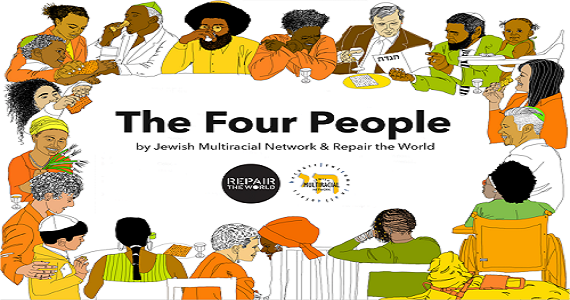The Torah speaks of four Daughters: one possessing wisdom of the heart, one rebellious, one simple and pure, and one who cannot ask questions.
The daughter possessing wisdom of the heart, what does she say? “Father, your decree is harsher than Pharoah’s. The decree of the wicked Pharoah may or may not have been fulfilled, but you who are righteous, your decree surely is realized.” The father heeded his daughter (Miriam). So we too follow in her steps with drums and dancing, spreading her prophecy amongst the nations.
The rebellious daughter, what does she say? “Recognize” the ways of enslavement and the tyranny of man’s rule over man. Although she rebels against authority it is said: She was more righteous than he, and we enjoy no freedom until we have left our unjust ways.
The simple and pure daughter, what does she say? “Wherever you go, so shall I go, and where you rest your head so there will I rest mine. Your people are mine, and your God my God” (Ruth, 1:16). We shall indeed fortify her in her loyalty to those she loved, and it was said to her: “May God make the woman who is coming into your house like Rachel and Leah, both of whom built up the House of Israel.”
And the daughter who cannot ask – only her silent weeping is heard, as it is written, “and she wept for her father and mother.” We will be her mouthpiece and she will be for us a judge. We will return her to her mother’s house and to her who conceived her, and we will proclaim “liberty in the land for all its inhabitants.”
Commentary:
Each of the Four Daughters expresses a unique path from bondage to freedom in a national and human sense. They learn from examining their parents’ lives and from the struggle of their nation, while their parents themselves are exposed to new spiritual layers as a result of their daughter’s education.
Wise of Heart: According to the Midrash, young Miriam persuaded her father Amram and the other enslaved men of Israel not to separate from their wives despite Pharoah’s decree to destroy all male newborns. When her mother Yocheved gave birth to a boy, the two worked together to save the new son/brother. Miriam recognized the historical significance of this nascent struggle, as she did at the splitting of the Red Sea, and thus led her people to redemption (Talmud Bavli, Sotah 12).
Rebellious: Tamar’s complex relationship with her father-in-law, Judah, son of Jacob our forefather, expresses a rebellion whose result was critical to the continuation of the tribe of Judah and the Jewish people. With her deeds, Tamar barricaded herself against her loss of freedom as an imprisoned widow. She eventually achieves the yibum (levirate marriage) to which she is entitled, and becomes the “founding mother” of the Davidic dynasty, symbol of messianic redemption (Tamar, Genesis 38:26).
Simple and Pure: Ruth the Moabitess remained true to her mother-in-law Naomi, and her ingenuous loyalty is absolute. This wonderful emotional closeness that Ruth so adamantly demonstrates rescues both of them from poverty and internal bondage (Ruth 4:11).
The One Who Cannot Ask: This last of the four daughters lacks sufficient freedom to taste even slightly the redemption and thus remains weeping in utter slavery. Although the ‘beautiful captive’ from war is allowed to grieve for her parents before she is taken (Deuteronomy 21:13), she is a reminder of the reality of silenced bondage, which continues to exist in our midst in various ways. The silent weeping that erupts from this dark reality is a call to action for the cause of freedom and liberty of every man and woman (Leviticus 25:10), born in the image of God, in order to live securely in their homes, among their people and loving family (Song of Songs 3:4).
Originally written for the pluralistic haggada Halaila Hazeh, edited by Mishael Zion.












